|
 Amanita pekeoides Amanita pekeoides
SynonymsAmanita vaginata var. punctata
Amanita vaginata var. umbrinolutea
Agaricus vaginatus
BiostatusPresent in region - Indigenous. Endemic
Images (click to enlarge)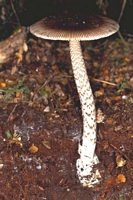
Owner: Peter Johnston | 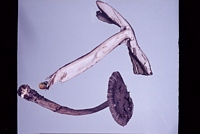
Owner: Herb. PDD | 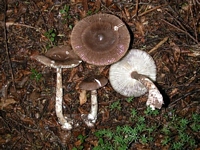
Caption: fruitbody
Owner: J.A. Cooper | 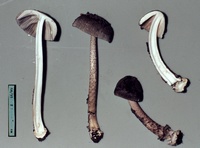
Caption: ZT68-035
Owner: E. Horak: © Creative Commons Attribution-Noncommercial 3.0 New Zealand | 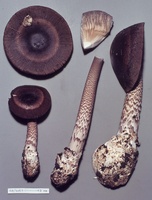
Caption: ZT68-406, Holotype
Owner: E. Horak: © Creative Commons Attribution-Noncommercial 3.0 New Zealand | 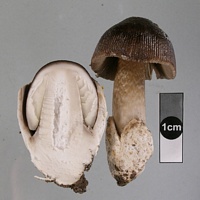
Caption: universal veil formation.
Owner: J.A. Cooper | 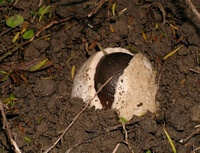
Owner: J.A. Cooper | 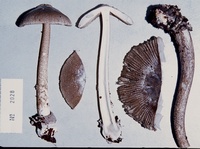
Caption: ZT2028
Owner: E. Horak: © Creative Commons Attribution-Noncommercial 3.0 New Zealand | 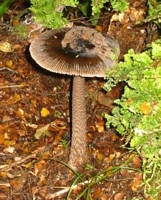
Owner: Bronwyn Dee | 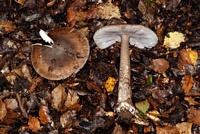
Owner: J.A. Cooper | 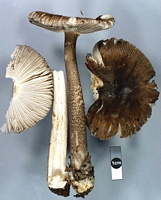
Owner: J.A. Cooper | 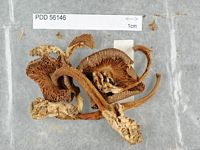
Caption: Dried type specimen
Owner: Herb PDD | 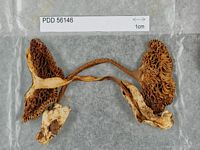
Caption: Dried type specimen
Owner: Herb PDD | 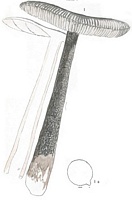
Caption: Plate 3: 1, Amanita vaginata var. punctata, x 1 ; 1a, spore, x 2000
Owner: PDD |
Article: Ridley, G.S. (1991). The New Zealand species of Amanita (Fungi: Agaricales). Australian Systematic Botany 4(2): 325-354.
Description: Basidiocarps small to medium, solitary to subgregarious. Pileus 32-82 mm, convex to plano-convex, then plano-depressed, with sulcate margin (0.17-0.31 R), entire, occasionally splitting along furrows, disc hazel to dark greyish sepia, paling to greyish sepia at margin, sulcate ridges concolorous with disc, furrows pale greyish sepia or vinaceous buff, slightly viscid when wet, quickly drying, volva remnants absent. Lamellae crowded, free, 6-10 mm wide, pale buff to buff, margin entire, brown vinaceous to dark greyish sepia at margin; lamellulae truncated. Stipe 70-120 mm high, 7-10(-17) mm diameter, hollow, tapering apically, surface pale greyish sepia, with hazel to greyish sepia, striate bands, becoming finer and more numerous towards apex. Exannulate. Volva 30-58 mm high, fleshy when young, 1-3 mm thick, becoming membranous with age, saccate, usually bilabiate, buff with ochreous to fulvous stains, with small, membranous, inner limb. Context in pileus white, pale brown vinaceous to pale sepia beneath disc, stipe white.
Spore print white. Basidiospores (520/38), (9.5-)10.5-14.5(-20) x (9-)10.5-14.5(-18) µm, Qm 1.00, Q 1.00-1.14, globose to subglobose, thin-walled, hyaline, inamyloid. Basidia 50-92.5 x 10.5-22.5 µm, 1-4-spored, not clamped. Lamella margin cells 12-58(-70) x 9-50 µm, globose, clavate, napiform, sphaeropedunculate, usually hyaline, rarely pale umber. Pileipellis consisting of 20-40 µm wide, slightly gelatinised suprapellis, non-gelatinised subpellis. Volva trama in three layers, outer layer regular, central layer subregular and occasional interspersed with clavate cells, inner layer regular.
Two distinct variations from the norm have been observed and for convenience are referred to as 'individuals with friable volva' and 'white individuals'.
Individuals with friable volva. As above but pileus and stipe with felted patches of greyish sepia to dark greyish sepia volva remnants. Volva remnants composed of abundant, terminal, pale umber, globose to clavate cells, 26.5-82 x 20-78 µm, single or in short chains, on abundant, pale umber, branching hyphae, 6-11 µm wide, tending to vertically orientated (Fig. 4d, h).
White individuals. As above but pileus white to sordid white.
Article: Stevenson, G. (1962). The Agaricales of New Zealand: II. Kew Bulletin 16(1): 65–74.
Description: The characters of this variety are dark-grey colour of cap and stipe;
grey gills with finely serrulate margins which in the New Zealand collection
were also dark-grey on the serrulate edges. Gilbert gives exceptional variations for spore size, 10.4-14 x 17-18um. Spores of the New Zealand collection, which otherwise agrees with this variety, were 12um diam., corresponding with typical A. vaginata. The original publication of Cleland & Cheel
has a colour plate with distinctly reddish colouration, not agreeing exactly
with the description. The New Zealand form illustrated here is darker.
Habitat: under Nothofagus solandri, Nelson, 5.3.1955, Stevenson.
Article: Stevenson, G. (1962). The Agaricales of New Zealand: II. Kew Bulletin 16(1): 65–74.
Description: This variety is distinguished by a brown coloured cap and stipe, spores
globose 12-16um diam. The New Zealand collections had medium brown cap
and stipe, spores globose, 12um diam.
Habitat: under second growth scrub, Wellington, 3.5.1951, Stevenson;
under Jvothofagus solandri, Taita, 18.3.1958, Stevenson; under N. solandri
Muritai, 29.3.1958, Marie Taylor.
|